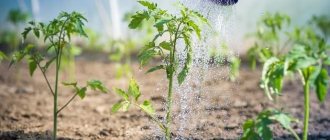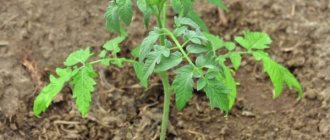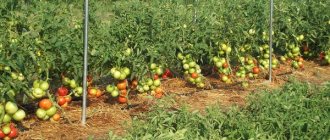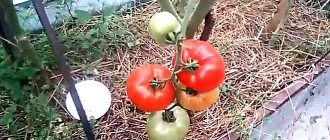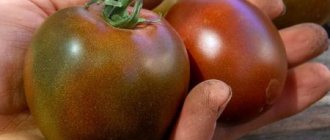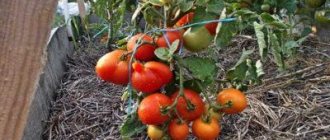Beautiful bright tomatoes are a decoration for any dish. Delicious cocktail Pinocchio is valued for its excellent taste characteristics, elegant appearance, and unpretentiousness. It contains many useful substances - iron and potassium, lycopene, vitamins A, B, C. The variety is successfully grown on window sills and ordinary beds.
| Height | Landing location | Ripening time | Fruit color | Fruit size | Origin | Fruit shape |
| short | Greenhouse, Open ground | Early ripening | Reds | Small | Variety | Round |
Description and characteristics of the variety
The Pinocchio tomato variety is recommended for compacted plantings in greenhouses or open ground. Small bushes have an attractive and decorative appearance, so they are often used to decorate borders and garden spaces. Most often, this variety is planted with tall crops.
- An early ripening variety that produces ripe fruits 90 days after seed germination.
- A determinate type of bush, the plant grows to a height of no more than 30 cm. Due to its small size, the bushes do not require staking to a support, as they have a strong and powerful stem that can easily support a crown with small fruits.
- Standard, therefore does not require shaping and pinning.
- Decorative, in appearance it resembles a small tree with dark green leaves.
- The bush bears many flower clusters, each of which produces about 10 tomatoes.
- An adult, fully formed plant resembles one large bunch.
- High yield compared to similar varieties. From 1 bush you can collect up to 1.6 kg of small ripe vegetables.
- Resistant to most nightshade diseases.
- Plants do not tolerate spraying, which causes excess moisture to accumulate on the leaves.
- The variety is easy to care for and does not require additional lighting in the spring.
- Responds well to fertilizing and loosening the soil.
Advice! When grown indoors, seeds can be sown at any time and the harvest can be obtained all year round.
Characteristics of Pinocchio tomatoes
The Pinocchio tomato is heat-loving. From cold soil, its root system cannot receive enough nutrients, and the plants stop growing. The variety is not drought-resistant either. A lack of moisture can lead to the formation of barren flowers.
If you follow the rules of agricultural technology, he will definitely delight you with sweet cherry tomatoes. They do not crack when ripe and do not fall off the branches, which is confirmed by photos of Pinocchio tomatoes taken by gardeners. Ripening occurs at the end of June - beginning of July. This is if you grow tomatoes outdoors. In general, the variety reaches biological maturity 90-100 days after emergence.
The yield of Pinocchio tomato is low. Breeders claim that you can get up to 1.5 kg of fruit from 1 bush. Vegetable growers say that such yields can be achieved only by growing the variety in open ground and carefully following the rules of agricultural technology.
Advantages and disadvantages
The Pinocchio tomato variety has its advantages and disadvantages. First let's talk about the advantages:
- Decorative appearance of a bush.
- Early fruit ripening.
- Can be grown all year round.
- Does not require shaping, pinning, or tying to supports.
- Easy to care for.
- Resistant to nightshade diseases.
- Suitable for indoor growing in pots.
Among the many advantages of this variety, only one drawback can be identified:
- Does not tolerate spraying.
Cultivation in open ground
In the southern regions, you can move Pinocchio tomato seedlings to the beds in mid-May. For the Northern strip, suitable planting dates are the end of May or the beginning of June.
In open ground, they adhere to the arrangement between the bushes - 50 by 30 cm.
Planting process:
- The seedling is carefully removed from the cup, trying not to damage the earthen lump.
- Place the plant in the center of the prepared hole so that the lower leaves are located just above the edge of the hole.
- Sprinkle with earth and press it around the bush.
- Water generously.
The procedure is carried out on a cloudy morning or evening.
Agricultural technology for cultivating in beds is standard:
- Watering as needed;
- Loosening the soil once a week.
- Feeding 3 times per season.
When cultivated in open ground, Pinocchio does not need as frequent feeding as when kept in pots on a windowsill or balcony. There the plant is kept in a confined space and quickly consumes the nutrients that it needs to be supplied through regular feeding.
When grown in beds for the first time, the crop is fed after transplantation after 2 weeks. Then Pinocchio is fertilized in the flowering phase, adhering to the same rules in feeding the tomato as when maintaining a house. Use specialized fertilizers marked “Ovary” or boric acid. Pinocchio also responds well to feeding with superphosphate.
In open ground, it is imperative to prevent fungal diseases by spraying the bushes with Fitosporin.
The first harvest begins to form in early to mid-August.
Features of cultivation
The timing of planting seeds depends on the desired time of harvest. To get a harvest of ripe tomatoes all year round, you need to plant the bushes at short intervals and follow the rules of cultivation and care.
For example, to get a harvest for the New Year's table, seeds are sown in early October. If you plant tomatoes in early December, the fruits will ripen by early March.
Important! In winter, there is very little daylight, so seedlings and tomatoes will need to be illuminated.
In summer, Pinocchio tomatoes can be grown outside in boxes, pots or flowerpots. And with the onset of frost, tomatoes can be placed on windowsills in the house.
In this case, the boxes must be at least 10 cm in height to ensure comfortable and proper development of the root system of the bush.
Important! For one low-growing plant, the capacity should be at least 5 liters.
To cultivate Pinocchio tomatoes in open ground, seeds are sown in late March or early April. For comfortable development of the root system and plant nutrition, it is important to choose the right soil composition. You can prepare the correct soil mixture yourself. To do this take:
- garden soil - 5 parts;
- old humus - 5 parts;
- peat - 2 parts;
- sand - 2 parts;
- wood ash - ¼ part;
- potassium sulfate and urea - 1 tbsp. spoon.
Advice! Before preparing the soil mixture, it is recommended to disinfect the garden soil with a weak solution of potassium permanganate or calcine it in the oven.
Drainage is laid out at the bottom of the boxes, then the soil mixture is filled in. If you cannot prepare soil for seedlings yourself, you can purchase it at a specialized store. The main thing is that the soil is light, breathable, and slightly acidic.
Before sowing, the seeds must be disinfected in a weak solution of potassium permanganate. To do this, they are poured into a 1% solution and kept for no longer than 20 minutes, then washed with warm water and lightly listened to. It is also recommended to soak the seeds for 10 hours in Zircon growth stimulator to speed up seed germination and stimulate immunity.
After these procedures, the seeds immediately drink the prepared soil.
Advice! If you sow directly into peat cups, you will not need to pick in the future. To do this, each cup is buried under 2 seeds, so that later a stronger seedling can be selected.
Important! You cannot sow Pinocchio tomato seeds directly into large pots.
The root system of these tomatoes develops very slowly, so it simply cannot take root in a large pot right away.
In order for seedlings to develop well, they must be kept in a room with a temperature of about 22 degrees, which is well lit for at least 12 hours a day. Seedlings also require moderate watering with settled water at room temperature. Water the plants only when the top layer of soil is completely dry.
Growing in open ground
Seedlings of the Pinocchio variety can be planted in open ground only after its temperature has warmed up to 15 degrees.
Attention! At colder temperatures, seedlings will not absorb nutrients.
After planting, the bushes must be watered every day with warm water and fertilized once every 2 weeks.
First, feed with complex fertilizers (35-40 g of superphosphate (double), 20 g of potassium sulfate and 15 g of urea per 10 liters of water). This mineral complex saturates the tomatoes with nitrogen, potassium, phosphorus and other minerals, and during the flowering and fruiting period they additionally add fertilizer with potassium salt (dissolve 1 tablespoon of complex mineral fertilizer Azofoska in 10 liters of water and water 0.5 -1 liter per bush .)
Also, do not forget about loosening the soil.
Important! It is necessary to water the bushes at the root so as not to soak the leaves, otherwise they may become infected with late blight.
Planting is carried out according to the following scheme: per 1 sq. m up to 6 plants. However, it is best to keep the interval between bushes at 50 cm.
Growing on the balcony
This variety can be cultivated on a balcony or loggia that faces south, southeast or southwest. The soil must be fertile, since the plants will be grown in a confined space. It is prepared according to the recipe described above for seedlings.
According to reviews from gardeners who have already dealt with growing the Pinocchio tomato variety on the balcony, it is best to use pots or boxes with a volume of at least 5 liters. 5 liter plastic bottles work well for this. However, do not forget to make holes in them to drain excess water.
When growing plants in pots, they need to be properly cared for. The main thing is not to forget to water and fertilize on time. Fertilizers are applied every two weeks using a weak solution of complex mineral fertilizer. After applying fertilizers, it is necessary to water the bushes.
Also, do not forget about loosening the soil, as this helps air penetrate to the roots faster.
If the weather is cloudy for a long time, it is better to illuminate the tomatoes with phytolamps. To ensure that the bushes receive sunlight evenly, they are rotated 180 degrees every day. Tomatoes that grow on a balcony or loggia are self-pollinated.
Growing on a windowsill
- This type of growing the Pinocchio tomato variety is slightly different from the balcony one. The correct temperature regime must be maintained in the room: about 23 degrees during the day, and no more than 18 degrees at night. Watering is carried out in such a way as to completely wet the entire earthen ball. Don't forget about fertilizing. 2-3 times with complex fertilizers mentioned above.
More information about growing tomatoes is described in the article: Technology of growing tomatoes. Secrets of planting and care
You might be interested in: How to properly plant tomatoes in a greenhouse: bush formation diagram, care features, photos and videos
Useful information: How to properly tie tomatoes in open ground: the best methods, step-by-step photo and video instructions
Description of Pinocchio tomato
Pinocchio tomatoes can be grown anywhere in the world. Initially, it was positioned as a variety for growing in open ground. However, passionate gardeners began to grow dwarf tomatoes at home. This is confirmed by numerous reviews and photos of Pinocchio tomatoes made by vegetable growers.
Attention!
The Pinocchio tomato is a cultivar. This means that you can prepare its seeds yourself.
Determinate type plant. The bushes do not exceed a height of 30-40 cm. The tomato is standard, with a powerful central stem. However, during the fruiting period it needs support. The leaves are more like potato leaves. The leaf blades are oval, with a wrinkled surface of a dark green color.
It blooms with small yellow funnel-shaped flowers. The buds, and then the tomatoes, are collected in long brushes. Up to 10 cherry tomatoes are formed on each. Tomatoes are round or flat-round in shape. Their diameter is only 2-3 cm, and their weight is from 20 to 40 grams. The thin, almost transparent skin is painted scarlet.
The fruits are quite dense. They are characterized by a high content of dry matter and sugars. The taste is sweet, with a slight sourness in the aftertaste.
The Pinocchio tomato is an unpretentious species in terms of cultivation. The absence of stepsons and the good immunity of the plant significantly facilitates care. But it loves good lighting and fertile soil. During the flowering period, it requires watering.
Harvest and storage
The description of the variety says that the harvest time depends on the period when the seeds were sowed. If planting was done in February, then the yield of tomatoes from the plant can be expected in June. The peculiarity of tomatoes is the formation of clusters of fruits and their subsequent ripening in turn. Vegetables are removed when they reach a rich red color.
See also
Description of the mid-season tomato Cheerful Neighbor and agricultural cultivation techniques
Read
The maximum height of the plant is 30 cm; upon reaching this height, the formation of bushes stops and fruiting ends. If the shoots cannot provide the fruits with sufficient nutrients, it is recommended to remove the remaining Pinocchio tomatoes and wait for them to ripen. To do this, the fruits are placed in a dark, cool place for some time.
